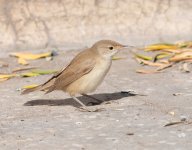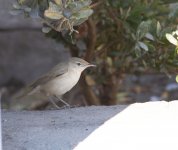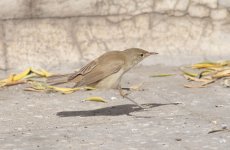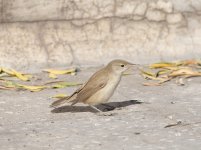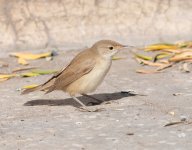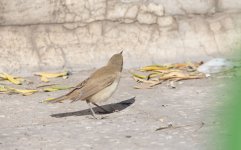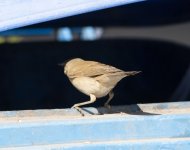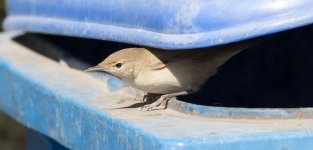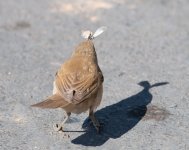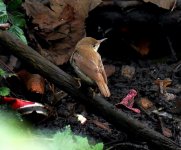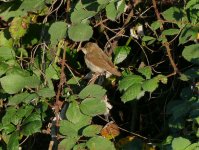-
Welcome to BirdForum, the internet's largest birding community with thousands of members from all over the world. The forums are dedicated to wild birds, birding, binoculars and equipment and all that goes with it.
Please register for an account to take part in the discussions in the forum, post your pictures in the gallery and more.
You are using an out of date browser. It may not display this or other websites correctly.
You should upgrade or use an alternative browser.
You should upgrade or use an alternative browser.
ID warbler,iran (1 Viewer)
- Thread starter king2122
- Start date
More options
Who Replied?Deb Burhinus
Used to be well known! 😎

A Caspian Reed perhaps?
It looks like one to me as well.A Caspian Reed perhaps?
I know in Dubai, where I used to live, they used to pass through into November but this must be a late one this far north in mid-Nov.
Deb Burhinus
Used to be well known! 😎

Just to elaborate, looking at it more closely - It has that ‘Blyth’s’ colour tone doesn’t it ? (lack of Emarg. to P4 (or maybe very very slight narrowing only?) and long PP rules out Blyth’s) yet it lacks the yellow and olive tones of Marsh or the rufous of nominate E. Reed both on rump or mantle. The underparts look very clean to me.
The bare part colouring don’t really favour Marsh imo, nor the rather sturdy feet) and it looks particularly pointy, long-winged to me (and too long-billed for Marsh?) so maybe a long distant migrant Eastern Reed Warbler rather than a more ’local’ breeder? The problem with Acro warblers is their colour tones change from one minute to the next and from photo to photo so it’s hard to judge what the true tones might be. It’s a shame there are not more images, it would be good to get a clearer look at the wing esp. where P2 finishes in relation to P4 as afair this is supposed to be longer in fuscus. I expect there’s some images and decent literature out there to better sort out the identifying criteria for fuscus but I don’t have access to any unfortunately at the moment- I am not sure scirpaceus and fuscus could be separated with any certainty just on a single image anyway at least I couldn’t- someone with more experience may be able to!
The bare part colouring don’t really favour Marsh imo, nor the rather sturdy feet) and it looks particularly pointy, long-winged to me (and too long-billed for Marsh?) so maybe a long distant migrant Eastern Reed Warbler rather than a more ’local’ breeder? The problem with Acro warblers is their colour tones change from one minute to the next and from photo to photo so it’s hard to judge what the true tones might be. It’s a shame there are not more images, it would be good to get a clearer look at the wing esp. where P2 finishes in relation to P4 as afair this is supposed to be longer in fuscus. I expect there’s some images and decent literature out there to better sort out the identifying criteria for fuscus but I don’t have access to any unfortunately at the moment- I am not sure scirpaceus and fuscus could be separated with any certainty just on a single image anyway at least I couldn’t- someone with more experience may be able to!
king2122
Active member
Tanx for reply, fortunately I found some another photos from my backup hard drive.here are these:Just to elaborate, looking at it more closely - It has that ‘Blyth’s’ colour tone doesn’t it ? (lack of Emarg. to P4 (or maybe very very slight narrowing only?) and long PP rules out Blyth’s) yet it lacks the yellow and olive tones of Marsh or the rufous of nominate E. Reed both on rump or mantle. The underparts look very clean to me.
The bare part colouring don’t really favour Marsh imo, nor the rather sturdy feet) and it looks particularly pointy, long-winged to me (and too long-billed for Marsh?) so maybe a long distant migrant Eastern Reed Warbler rather than a more ’local’ breeder? The problem with Acro warblers is their colour tones change from one minute to the next and from photo to photo so it’s hard to judge what the true tones might be. It’s a shame there are not more images, it would be good to get a clearer look at the wing esp. where P2 finishes in relation to P4 as afair this is supposed to be longer in fuscus. I expect there’s some images and decent literature out there to better sort out the identifying criteria for fuscus but I don’t have access to any unfortunately at the moment- I am not sure scirpaceus and fuscus could be separated with any certainty just on a single image anyway at least I couldn’t- someone with more experience may be able to!
Attachments
Deb Burhinus
Used to be well known! 😎

Thanks for posting the other images King2122 - it will be interesting to see what others think.
I was looking for an autumn fuscus to compare, the uae gallery https://www.smugmug.com/gallery/n-BVj3v/ only appears to be spring birds.Thanks for posting the other images King2122 - it will be interesting to see what others think.
As I said previously, my initial feeling was fuscus Reed warbler. I don't see anything to change that view at the moment but always ready to look. As you say the wing length is longer than western birds but typical of those I have seen.
I agree that the pp is far too long for Blyth's RW, and this is a seriously rare bird in Iran, although I see that these are being reported more often - I guess part of the expansion westwards of the range as a whole.
When I lived in the gulf the easiest separation of Marsh vs Reed was timing, Marsh went north late and came back early compared with Reed. Of course there were exceptions but it was a good rule of thumb. Working back, I still think this fits with Reed.
Deb Burhinus
Used to be well known! 😎

Yes, this was still very much my thoughts too after the new set of images but was interested to know if they would attract further input from others (I can’t see Marsh here for the reasons I outlined earlier).I don't see anything to change that view at the moment but always ready to look.
king2122
Active member
😂😂 .I saw this bird in the middle of desert in a rest area. she hunted the insects from rubbish bin😁No rubbish shots there king2122!
Particularly like image 8 (what looks like?) the bird emerging from a “wheelie bin” (Rubbish Bin).
Cheers👍
Deb Burhinus
Used to be well known! 😎

They are great photos btw😂😂 .I saw this bird in the middle of desert in a rest area. she hunted the insects from rubbish bin😁
Apologies I meant to say that earlier.
Thank you for posting them - it’s been helpful.
king2122
Active member
your welcome. and final answer is reed ?They are great photos btw
Apologies I meant to say that earlier.
Thank you for posting them - it’s been helpful.
Deb Burhinus
Used to be well known! 😎

The final answer is Caspian Reed Warbler Acrocephalus scirpaceus fuscusyour welcome. and final answer is reed ?
A sub-species of Eurasian Reed Warbler
( You’re welcome too btw 😉)
Last edited:
KenM
Well-known member
FWIW king2122, although my images are somewhat lacking compared to yours, this Reed Warbler (mooted by some as a possible fuscus) was present certainly until late December 2014 and endured a few below zero temps at night, which created a bit of interest at the time not unlike your ''Desert Rubbish Dump'' this was found in an overflow drain in the middle of a roundabout in N.East London, not only that, but it shared the ''drain'' with two overwintering Common Whitethroats!😂😂 .I saw this bird in the middle of desert in a rest area. she hunted the insects from rubbish bin😁
Essentially a Reed Warbler, all the biometrics point to A.scirpaceous albeit a very ''odd'' looking bird with (light dependant) white under-parts, bare parts appearing mostly yellowish and upper-parts again light dependant giving off a ''gingery''feel, I've certainly never seen a Reed Warbler showing these cosmetics (and I've seen many). It was put on BF at the time however, after much discussion it remained tentatively unassigned....un-streaked Acros. can often be a challenge!
Cheers
Attachments
Deb Burhinus
Used to be well known! 😎

Do you have a link to that discussion Ken? I would be interested to see the reasons people were mooting a fuscus.
Deb Burhinus
Used to be well known! 😎

It’s here KenApologies Deb, being a bit of a computer Luddite, I’ve been unable to navigate myself to the 2015 thread with the new layout, you’re probably much better with that exercise than moi...best of luck 👍

Unstreaked Acro in London.....
FWIW I looked for the RW today without success, ''first time'' in 19 visits, everything else present except the aforementioned! I recall that the Common Whitethroats were ''quite showy'' up until 9th Dec. disappeared, then re-appeared again on the 15th, Hoping it's still around...although I'm...
Not that it is of any value now - I agree, this was a very interesting record and well done for getting so many (inconclusive 😁) images! Interesting discussion - thanks for bringing it up again.
- clearly observers in the field had stronger fuscus impressions than could be realistically gleaned from the photos which aren’t helped by the broad spectrum of upper parts colour shown in different images (which is what we have come to expect from Acros even in the field!). FWIW, it did not look like a Marsh to me (for which a Dec record would be pretty unlikely) or Blyth’s to my eye but a fuscus or European Reed possibly from the Northern Eastern part of it’s range where clinally they approach fuscus in colour, especially when worn, which this one is to the point of being in poor feather condition. Which might have contributed to the feeling it was ‘different’ to the typical ERW we see in the UK? AFAIK, complete moult of ERW is typically between Sept-Dec in Africa but here is overlap with some fuscus populations -and where also moult can take place between December -March - so a fuscus en route to it’s wintering grounds would also be very worn although I’d be very surprised this one made it to where it needed to go. Wing formula also overlap (scirpaceus v fuscus) and I can’t see anyway how it can be judged accurately on a bird so worn as this was with broken tips on some of the primaries and abraded outer fringes to the secondaries? I’m not sure whether iris colour varies in ERW moving East but birds apparently are larger which might account for the bill length (accentuated by flattened poor condition worn feathers?). The wing length didn’t look particularly long (but too long for BRW imo) but at the end of the day, given the variation in wing lengths of different populations of fuscus, do biometrics really help in separating it from ERW? Also with the clinal/population variation in upperparts colour in both fuscus and ERW, in addition to how worn this individual was, how could this also be attributed to race with any accuracy? That’s the problem with putative extra-limital birds, they ‘unfairly?’ are subject to a higher standard of ’proof’ than those within their normal accepted range. At least, genetically, ERW and fuscus are clearly distinct. 😛
Interesting discussion on that thread - thanks for bringing it up again.
Last edited:
Brian J Small
Well-known member
A bit of reading on fuscus - https://britishbirds.co.uk/wp-content/uploads/article_files/V95/V95_N02/V95_N02_P042_061_A001.pdf
Brian S
Brian S
Users who are viewing this thread
Total: 2 (members: 0, guests: 2)




